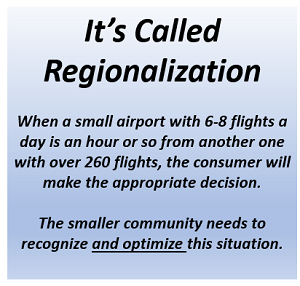Before We Start…
There’s A New Video Concept Coming In Aviation Analysis…
____________________
Hard Facts & New Better Air Service
Regionalization of Air Access Isn’t Coming.
It’s Already In Progress… Big Time
Let’s cut to the chase here.
Airline economics have changed. Airline fleets have changed. The air service options for communities have changed as a result. The approaches to air service access planning have not changed.
The imperative for every community is to identify and recognize the specific effects these changes will have on their airports in the coming year, and plan accordingly.
One New Critical Planning Criterion – The Consumer. This means taking an honest look at the future. No, not one that assumes or wishes the current air transportation system will remain in place. With the structural shifts in the airline industry, air service planning today needs to be founded on one new core issue: where it stands in regard to alternative consumer travel options.
The key is to anticipate, plan accordingly and not get blind-sided by a trend that’s increasingly obvious, but often missed entirely.
It’s called regionalization of air access.
It was demonstrated last month, where United, American and Delta yanked or reduced service at a number of small and mid-size airports. These were not just strategic changes – they were the clear indications of a major shift in the economics of air transportation.
The Goal Is Not Just “Air Service” But What It Represents. Planning for the future demands clear, unvarnished understanding that the number one objective of any community or region is to assure communication connectivity with the rest of the world. Here’s a hard fact… scheduled air service at the local airport will be only one factor. In some cases, a declining or disappearing factor. Consumers are finding superior options to what the local airport can support.
Moving ahead, the Airports:USA® traffic demand forecast for 2022 indicates that – at best – enplanements will be @90% of what was seen in 2019. Then toss in the accelerated down-shift of business traffic combined with increased low-fare leisure segments, and we don’t need to confer with a Rhodes scholar to see that the air transportation business – and the related revenue streams – are going to be materially different.
Different Airliners = Different Airline Strategies. One of the first and most impactful areas will be a continued re-fleeting. More 50-seat jets will get retired for economic reasons. On the other end, airliners such as the A220 and the A321XLR will open new nonstop air service options that weren’t possible in the past at a lot of mid-size non-connecting hub airports.
 This expanded air service will increase the economic potential of whole regions. In addition, however, the general result will be more regional concentration of air access.
This expanded air service will increase the economic potential of whole regions. In addition, however, the general result will be more regional concentration of air access.
Take a look at Killeen, Texas. Including United’s soon-to-be discontinued service, the airport has roughly eight departures a day, to IAH and to DFW – neither of which are O&D destinations for Killeen. That means almost all consumers using Killeen are making at least one connection to their final destination.
Now, roughly 60-75 drive minutes away, there is Austin. It has over 260 flights a day, to over 60 nonstop destinations and virtually every other connecting hub in the USA.
That is the alpha and the omega of the small community air service challenge in many regions of the USA.
Fact: Killeen cannot compete with what AUS offers, and it never will. The remaining AA service likely can be supported by the flow that the carrier offers over DFW. But the fact is that Killeen’s main air gateway to the world is now Austin. GRK is secondary, and that’s a starting point on which any airport planning must be based. None of this is negative, unless politicians want to paint it that way.
That’s the situation at a number of points across the nation. In some cases, the drive to an alternative airport is even less than 60 minutes, and in some cases it’s a whole lot further. And in many cases, the geographic location of the smaller community isolates it entirely from this situation.… the local airport is the only option.
But the core fact remains: regionalization is in process, and smaller communities need to understand that this can represent opportunities for alternative economic applications of the local airport. For example, the city fathers at Killeen, instead of commissioning another air service “study” to find a replacement for United which does not exist, would do much better to embrace the value that AUS represents as an access point to and from the globe. It’s a sales point for future economic development.
Studying The Past Won’t Change Reality. Unfortunately, a lot – heck, the majority – of ASD programs peddled to small communities today are still geared to an airline industry that simply no longer exists. Like programs that generate a lot of expensive data and heat maps that have no earthly connection with the emerging realities of the post-pandemic air transportation system.
For example, concepts such as “catchment areas” and “leakage studies” have nearly zero value within this evolution. Here’s a fact: there is no geographic boundary that determines which airport a consumer will, or will be likely, to use. The real determination is based on service alternatives available, and attainable at the local airport. If they are not there – and cannot be attracted due to the small size of the local community – the passengers driving to an alternative airport are not “leakage” – they are the passenger base of that larger airport.
Within the context of alternative options and regionalization of air access, such as at places like Killeen, and Muskegon and Topeka, these concepts are not only obsolete, they are nonsense.
The route cuts experienced in the past three months are a wake-up call for smaller airports across the nation. There will be future cuts in network carrier access. No number of studies or civic hubris will change the economic realities of air service, but airports have control of their own economic future.
In the meantime, there will be more air service pink slips. But there will also be more airports such as Austin, and Boise and Grand Rapids delivering strong new air access for wider regions of the nation.
Change Means Opportunity. At BGI, we’ve identified emerging air service shifts in all regions of the nation. Unlike other consulting firms, we constantly and independently research aviation trends. So, when our clients call, we’re ready.
Our team can assist in crafting a strategic plan that optimizes the future. Commercial air service is a part of the program, but it’s positioning the airport for the future trends in all areas of aviation that counts.
The future always daunting when it’s unknown. That’s where we come in.
____________________________________________________
ON BEHALF OF BOYD GROUP INTERNATIONAL, WE WANT TO WISH EVERYONE A VERY MERRY CHRISTMAS, A HAPPY HOLIDAY SEASON, AND GOOD HEALTH!
